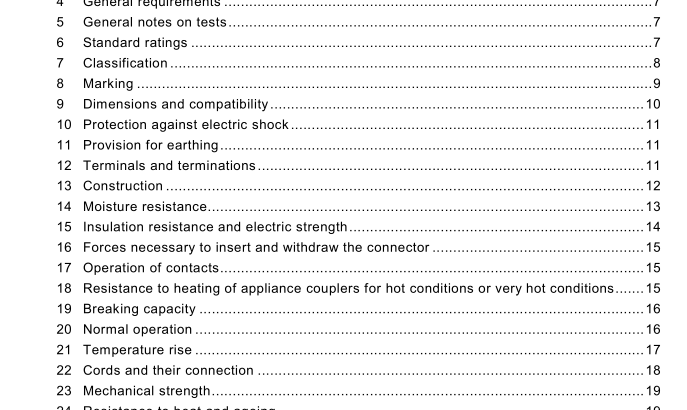IEC 60320-2-4:2009 pdf download – Appliance couplers for household and similar general purposes – Part 2-4: Couplers dependent on appliance weight for engagement
4 General requirements
This clause of IEC 60320-1 applies.
5 General notes on tests
This clause of IEC 60320-1 applies amended as follows:
5.2 Replacement:
The specimens are tested as delivered and under normal conditions of use, in accordance with the installation instructions of the manufacturer; they are tested with a.c. at 50 Hz or 60 Hz. Non-rewirable weight-engaged connectors shall be submitted with a cord at least 1 m long. For those clauses requiring the tests to be carried out on weight-engaged connectors and weight-engaged appliance inlets installed in accordance with the manufacturer’s instructions, representative appliances or appliance parts shall be supplied.
5.5 Replacement: For weight-engaged appliance inlets three specimens are required, to be subjected to the tests specified. For weight-engaged connectors six specimens are required:
– set 1 of three specimens is subjected to the tests specified, with the exception of those of Clauses 1 4, 1 5, 1 6, 1 9, 20 and 21 , and of 24.2;
− set 2 of three specimens is subjected to the tests of Clauses 1 4, 1 5, 1 6, 1 9, 20, 21 and 25.1 01 (including the repetition of Clause 1 6). For weight-engaged connectors which are declared as providing protection against liquid spillage, three additional specimens are required, which are subjected to the test of 1 4.2. For weight-engaged connectors of elastomeric or thermoplastic material, two additional specimens are required which are subjected to the tests of 24.2.1 or 24.2.2, whichever is applicable. For non rewirable weight-engaged connectors with indicators, three additional specimens with one pole of the indicator disconnected are required for the tests of Clause 1 5.
6 Standard ratings This clause of IEC 60320-1 is replaced as follows 6.1 The standard rated voltage is 250 V. Other rated voltages may be declared by the manufacturer provided they do not exceed 250 V.
6.2 The rated current shall be declared by the manufacturer. A coupler may have different current ratings dependent on use within specified applications. The rated current shall not in any case exceed 1 6 A. Compliance with the requirements of 6.1 and 6.2 is checked by visual inspection of the marking or the manufacturer’s instructions for installation and use.
7 Classification
This clause of IEC 60320-1 applies amended as follows:
7.1 Replacement:
7.1 Weight-engaged couplers are classified:
7.1.1 According to whether or not protection against liquid spillage is provided when the connector is installed according to the manufacturer’s instructions
7.1.2 According to type of equipment to be connected:
– appliance couplers for class I equipment;
– appliance couplers for class II equipment.
NOTE For a description of the classes, see IEC 61 1 40
7.1 .3 According to whether or not the coupler is intended to be engaged and disengaged with current flowing.
7.1 .4 According to the maximum ambient working temperature of the coupler.
NOTE The maximum ambient working temperature of the connector and appliance inlet may be different.
7.1 .5 According to the number of cycles to be performed in the test of Clause 20. Preferred values are:
7.1 .5.1 1 00 000
7.1 .5.2 60 000
7.1 .5.3 30 000
7.1 .5.4 20 000
7.1 .5.5 1 0 000
7.1 .5.6 6 000
NOTE Different numbers of endurance cycles may be declared for different current ratings of the same coupler. A cycle is two strokes as defined in Clause 1 9; that is one connection followed by one disconnection.
7.1 .6 The following information is recorded to cover required tests.
7.1 .6.1 According to the specified minimum cross-sectional area of cord.
7.1 .6.2 According to the maximum allowable terminal temperature rise.
7.1.6.3 According to the maximum allowable termination temperature rise.
7.1 .6.4 According to the maximum allowable contact temperature rise.
